Quality Assessment by Region and Land Cover of Sharpening Approaches Applied to GF-2 Imagery
Abstract
:1. Introduction
2. Materials and Methods
2.1. Study Area and Data
2.2. Method
3. Results
3.1. Visual Analysis
3.2. Quantitative Quality Assessment by Region
3.3. Quantitative Quality Assessment by Land Covers
4. Discussion
4.1. Impact of Pansharpening Methods in Different Regions and Imagries Acquired with Various Satellites
4.2. Impact of Pansharpening Methods in Different Land Covers
5. Conclusions
Author Contributions
Funding
Acknowledgments
Conflicts of Interest
Appendix A. The Original Multispectral (MS), Panchromatic (PAN), and Pansharpened Images in Several Regions

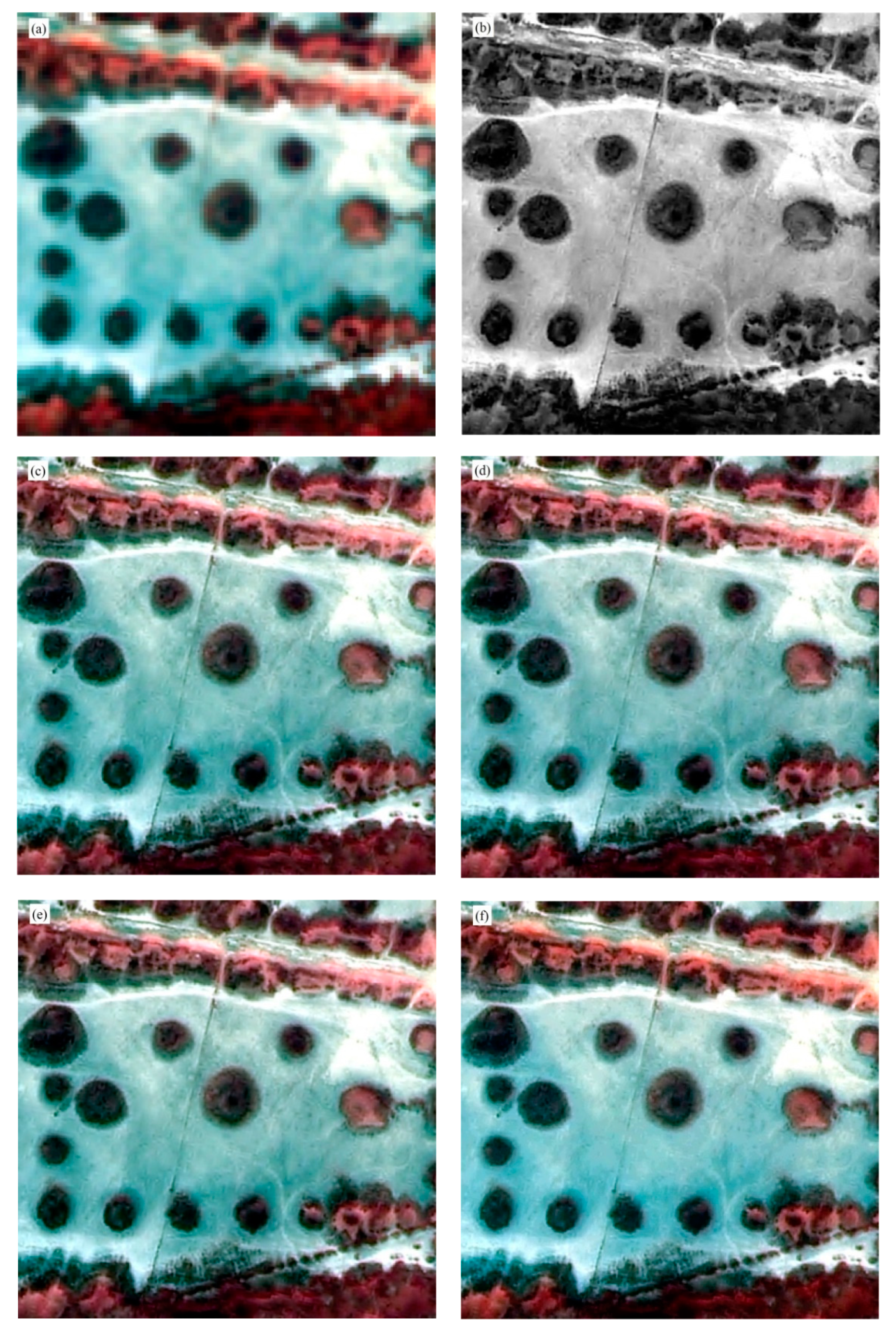
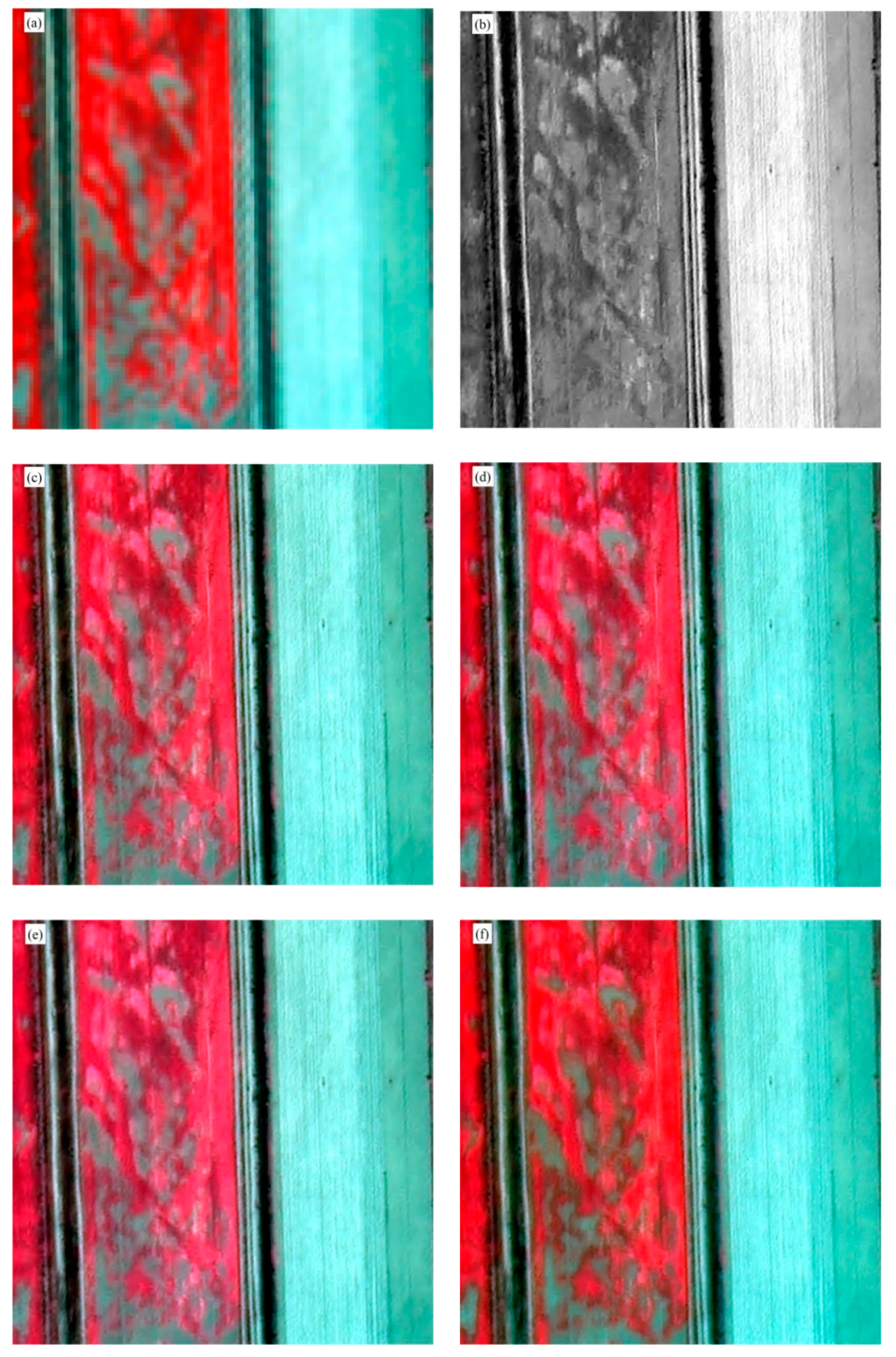
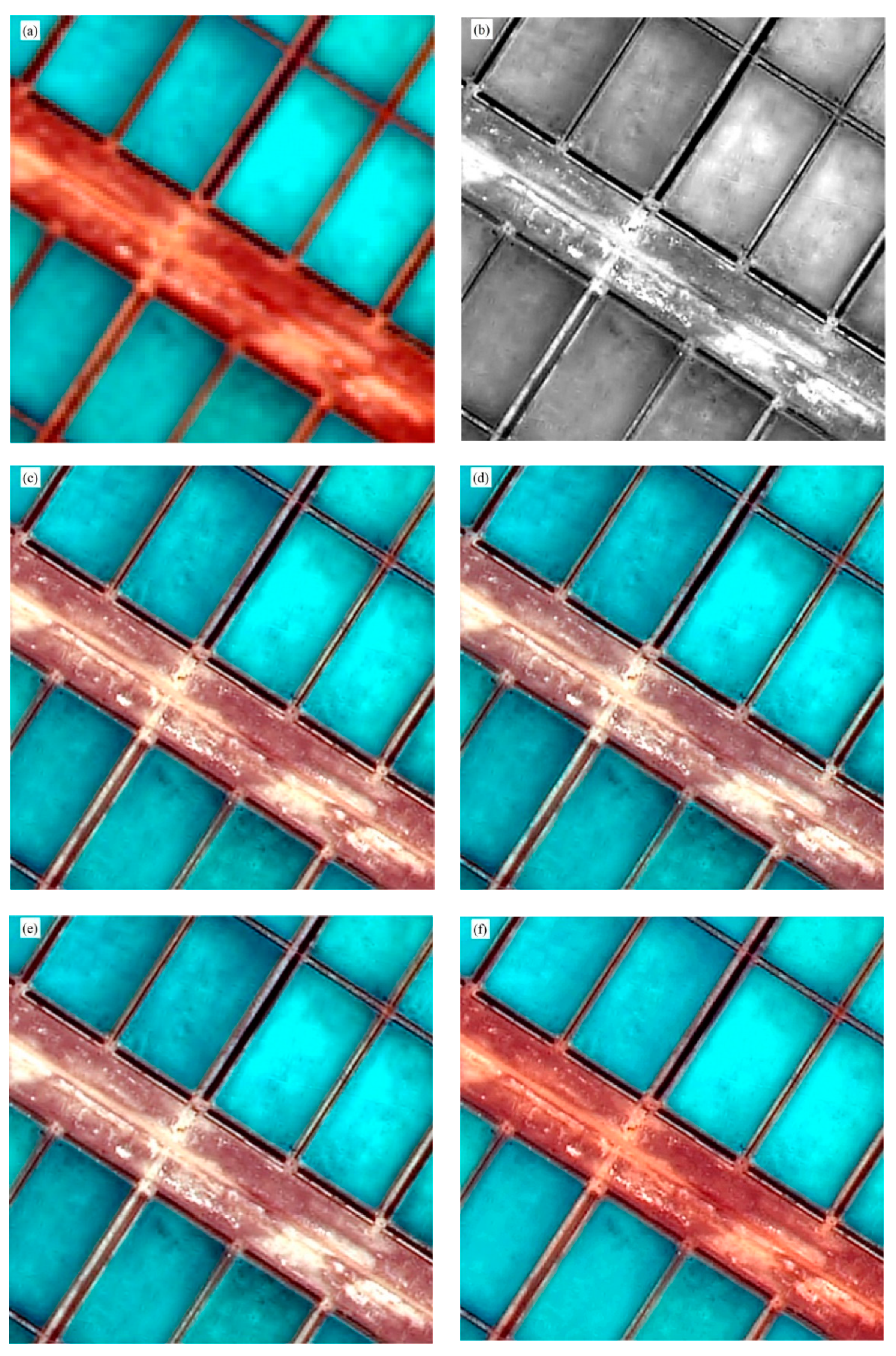
Appendix B. Sum of the Relative Differences of Each Quality Metric Index (Mean, Entropy (EN), MoranI, and Correlation Coefficient (CC) Value) of the Blue, Green, Red, and Near Infrared Bands for Each Pansharpening Method
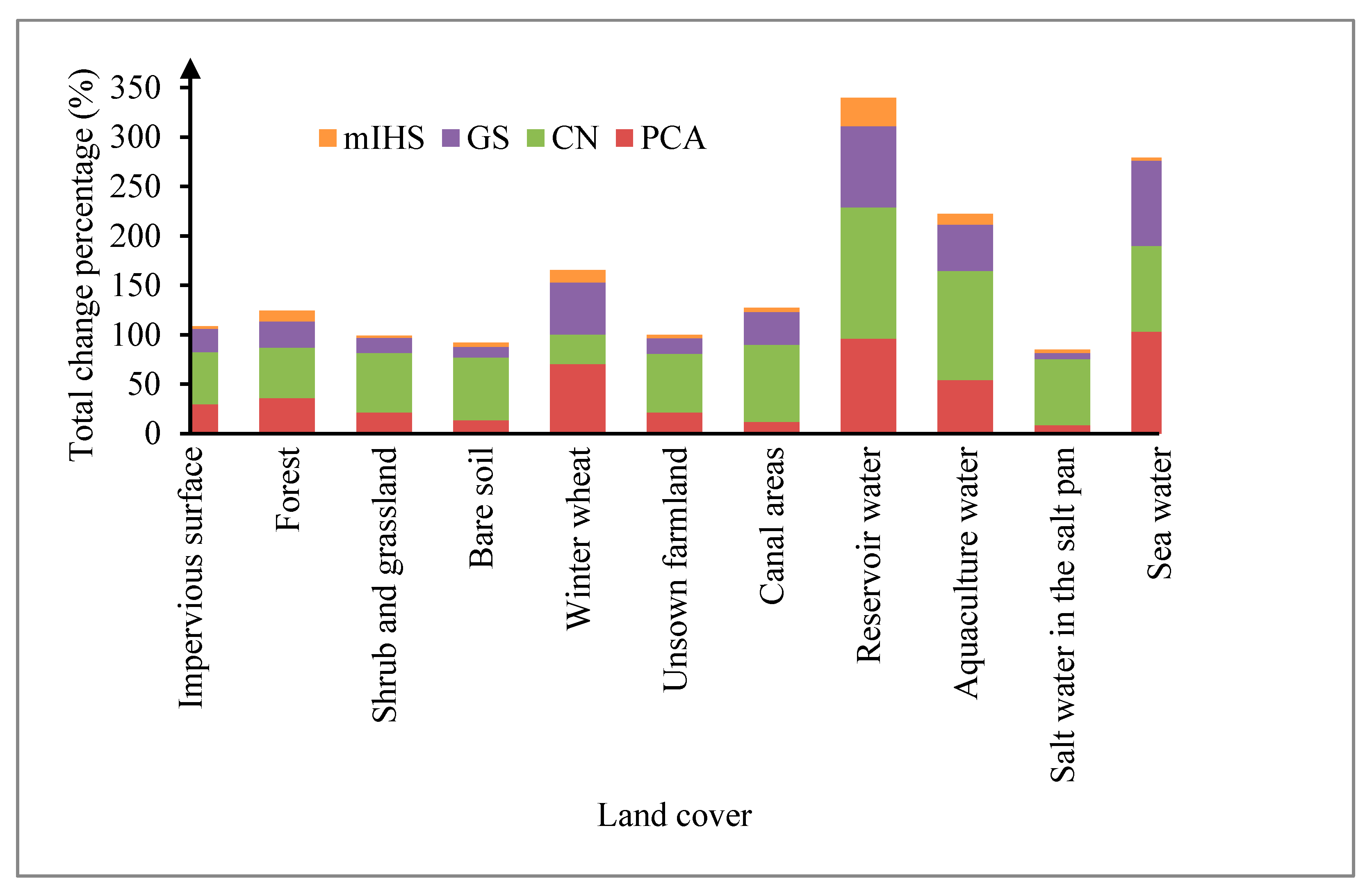
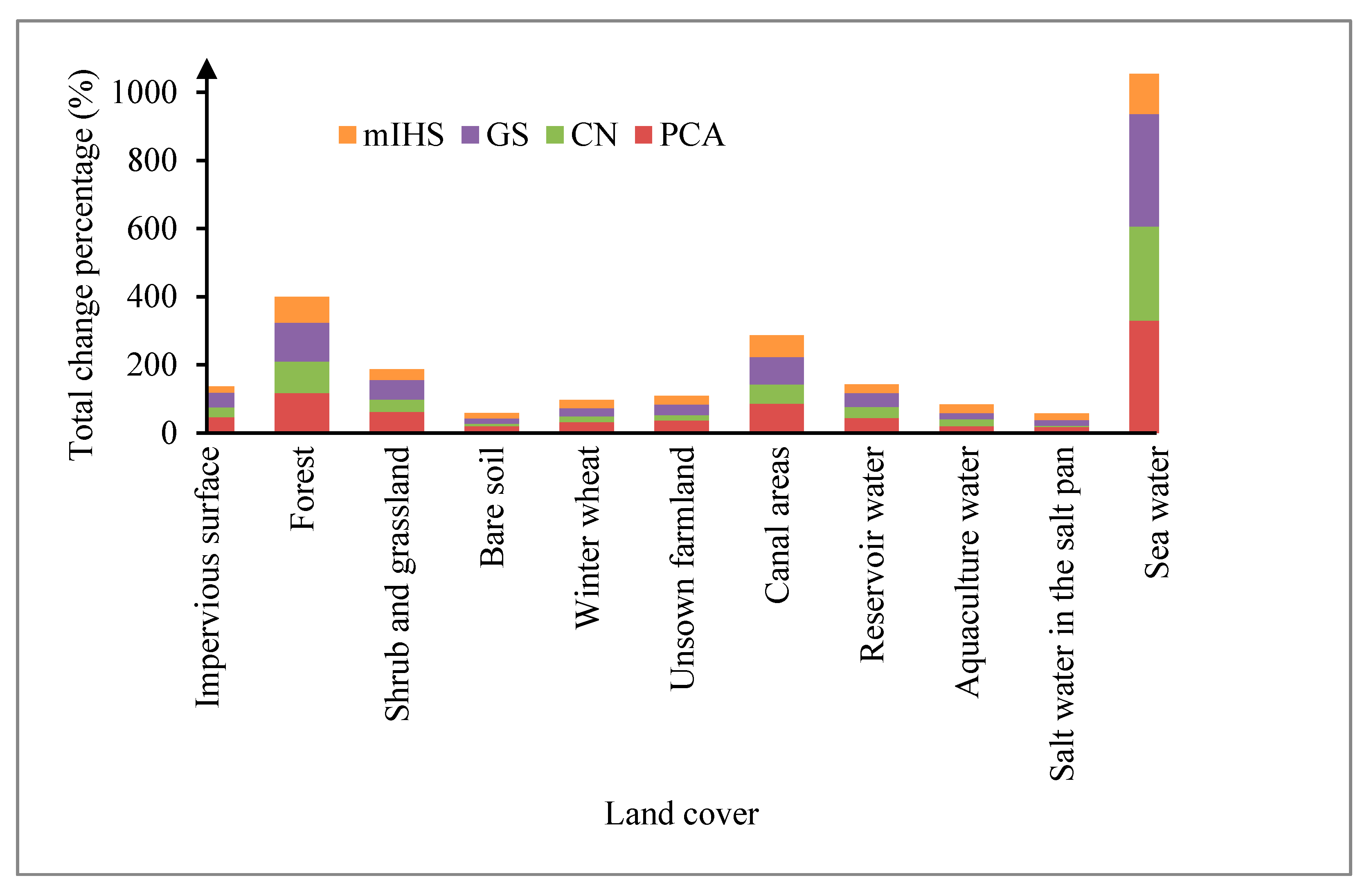
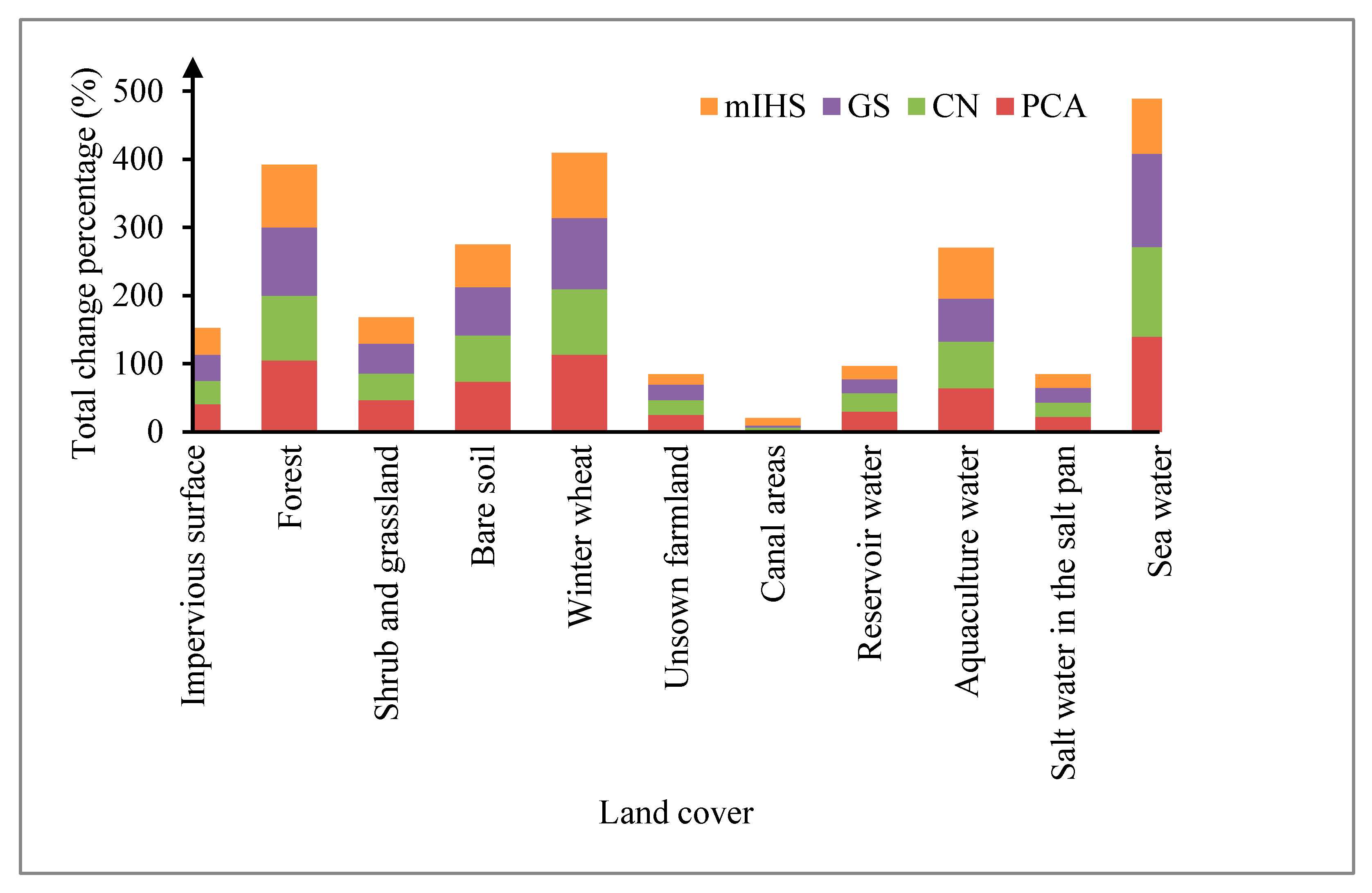

References
- Liu, Q. Sharpening the WBSI imagery of Tiangong-II: Gram-Schmidt and principal components transform in comparison. In Proceedings of the 14th International Conference on Natural Computation, Fuzzy Systems and Knowledge Discovery (ICNC-FSKD 2018), Huangshan, China, 28–30 July 2018; pp. 524–531. [Google Scholar]
- Jagalingam, P.; Arkal, V.H. A review of quality metrics for fused image. Aquat. Procedia 2015, 4, 133–142. [Google Scholar] [CrossRef]
- Lanaras, C.; Bioucas-Dias, J.; Baltsavias, E.; Schindler, K. Super-resolution of multispectral multiresolution images from a single sensor. In Proceedings of the IEEE conference on Computer Vision and Pattern Recognition Workshop, Honolulu, HI, USA, 21 July 2017; pp. 20–28. [Google Scholar]
- Zhang, L.; Peng, M.; Sun, X.; Cen, Y.; Tong, Q. Progress and bibliometric analysis of remote sensing data fusion methods (1992–2018). J. Remote Sens. 2019, 23, 603–619, (In Chinese with English abstract). [Google Scholar]
- Ranchin, T.; Aiazzi, B.; Alparone, L.; Baronti, S.; Wald, L. Image fusion-the ARSIS concept and some successful implementation schemes. ISPRS J. Photog. Remote Sens. 2003, 58, 4–18. [Google Scholar] [CrossRef] [Green Version]
- Das, A.; Revathy, K. A comparative analysis of image fusion techniques for remote sensed images. In Proceedings of the World Congress on Engineering 2007, London, UK, 2–4 July 2007. [Google Scholar]
- Ghassemian, H. A review of remote sensing image fusion methods. Inf. Fusion 2016, 32, 75–89. [Google Scholar] [CrossRef]
- Welch, R.; Ehlers, W. Merging multiresolution SPOT HRV and Landsat TM data. Photogramm. Eng. Remote Sens. 1987, 53, 301–303. [Google Scholar]
- Laben, C.A.; Brower, B.V. Process for Enhancing the Spatial Resolution of Multispectral Imagery Using Pan-Sharpening. U.S. Patent 6,011,875, 4 January 2000. [Google Scholar]
- Vrabel, J.; Doraiswamy, P.; McMurtrey, J.; Stern, A. Demonstration of the accuracy of improved resolution hyperspectral imagery. In Proceedings of the SPIE 4725, Algorithms and Technologies for Multispectral, Hyperspectral, and Ultraspectral Imagery VIII, Orlando, FL, USA, 2 August 2002; pp. 556–567. [Google Scholar]
- Siddiqui, Y. The modified IHS method for fusing satellite imagery. In Proceedings of the ASPRS 2003 Annual Conference, Anchorage, AK, USA, 5–9 May 2003. [Google Scholar]
- Nikolakopoulos, K.; Oikonomidis, D. Quality assessment of ten fusion techniques applied on Worldview-2. Eur. J. Remote Sens. 2015, 48, 141–167. [Google Scholar] [CrossRef]
- Li, H.; Jing, L.; Tang, Y. Assessment of pansharpening methods applied to WorldView-2 imagery fusion. Sensors 2017, 17, 89. [Google Scholar] [CrossRef]
- Khaleghi, B.; Khamis, A.; Karray, F.O.; Razavi, S.N. Mutisensor data fusion: A review of the state-of-the-art. Inf. Fusion 2013, 14, 28–44. [Google Scholar] [CrossRef]
- Renza, D.; Martinez, E.; Arquero, A. Quality assessment by region in spot images fused by means dual-tree complex wavelet transform. Adv. Space Res. 2011, 48, 1377–1391. [Google Scholar] [CrossRef] [Green Version]
- Haghighat, M.B.A.; Aghagolzadeh, A.; Seyedarabi, H. A non-reference image fusion metric based on mutual information of image features. Comput. Electr. Eng. 2011, 37, 744–756. [Google Scholar] [CrossRef]
- Zheng, Y.; Qin, Z. Objective image fusion quality evaluation using structural similarity. Tsinghua Sci. Technol. 2009, 14, 703–709. [Google Scholar] [CrossRef]
- Thomas, C.; Wald, L. Comparing distances for quality assessment of fused images. In Proceedings of the 26th EARSeL Symposium, Varsovie, Poland, 29 May–2 June 2006; pp. 101–111. [Google Scholar]
- Ma, J.; Ma, Y.; Li, C. Infrared and visible image fusion methods and applications: A survey. Inf. Fusion 2019, 45, 153–178. [Google Scholar] [CrossRef]
- Simone, G.; Farina, A.; Morabito, F.C.; Serpico, S.B.; Bruzzone, L. Image fusion techniques for remote sensing applications. Inf. Fusion 2002, 3, 3–15. [Google Scholar] [CrossRef] [Green Version]
- Kumar, G.R.H.; Singh, D. Quality assessment of fused image of MODIS and PALSAR. Prog. Electromagn. Res. B 2010, 24, 191–221. [Google Scholar] [CrossRef] [Green Version]
- Kotwal, K.; Chaudhuri, S. A novel approach to quantitative evaluation of hyperspectral image fusion techniques. Inf. Fusion 2013, 4, 5–18. [Google Scholar] [CrossRef]
- Md Reba, M.; Cuang, O. Image quality assessment for fused remote sensing imageries. J. Teknol. (Sci. Eng.) 2014, 71, 175–180. [Google Scholar] [CrossRef] [Green Version]
- Blasch, E.; Li, X.; Chen, G.; Li, W. Image quality assessment for performance evaluation of image fusion. In Proceedings of the 2008 11th International Conference on Information Fusion, Cologne, Germany, 30 June–3 July 2008; pp. 583–588. [Google Scholar]
- Han, Y.; Zhang, J.; Chang, B.; Yuan, Y.; Xu, H. Novel fused image quality measures based on structural similarity. J. Comput. 2012, 7, 636–644. [Google Scholar] [CrossRef]
- Alparone, L.; Alazzl, B.; Barontl, S.; Garzelll, A.; Nenclnl, F.; Selva, M. Multispectral and panchromatic data fusion assessment without reference. Photogramm. Eng. Remote Sens. 2008, 74, 193–200. [Google Scholar] [CrossRef] [Green Version]
- Ma, D.; Liu, J.; Chen, K.; Li, H.; Liu, P.; Chen, H.; Qian, J. Quality assessment of remote sensing image fusion using feature-based fourth-order correlation coefficient. J. Appl. Remote Sens. 2016, 10, 026005. [Google Scholar] [CrossRef]
- Yang, C.; Zhang, J.; Wang, R.; Liu, X. A novel similarity based quality metric for image fusion. Inf. Fusion 2008, 9, 156–160. [Google Scholar] [CrossRef]
- Pandit, V.R.; Bhiwani, R.J. Image fusion in remote sensing applications: A review. Int. J. Comput. Appl. 2015, 120, 22–32. [Google Scholar]
- Sarp, G. Spectral and spatial quality analysis of pan-sharpening algorithms: A case study in Istanbul. Eur. J. Remote Sens. 2014, 47, 19–28. [Google Scholar] [CrossRef] [Green Version]
- Wang, Q.; Shi, W.; Li, Z.; Atkinson, P.M. Fusion of Sentinel-2 images. Remote Sens. Environ. 2016, 187, 241–252. [Google Scholar] [CrossRef] [Green Version]
- Su, Y.; Li, Y.; Zhou, Z. Remote sensing image fusion methods and their quality evaluation. Geotech. Investig. Surv. 2012, 12, 70–74, (In Chinese with English abstract). [Google Scholar]
- Zhang, Y.; Mishra, R.K. A review and comparison of commercially available pan-sharpening techniques for high resolution satellite image fusion. In Proceedings of the 2012 IEEE International Geoscience and Remote Sensing Symposium, Munich, Germany, 22–27 July 2012; pp. 182–185. [Google Scholar]
- Ehlers, M.; Klonus, S.; Astrand, P.J.; Rosso, P. Muti-sensor image fusion for pansharpening in remote sensing. Int. J. Image Data Fusion 2010, 1, 25–45. [Google Scholar] [CrossRef]
- Han, Y.; Cai, Y.; Cao, Y.; Xu, X. A new image fusion performance metric based on visual information fidelity. Inf. Fusion 2013, 14, 127–135. [Google Scholar] [CrossRef]
- Vaiopoulos, A.D.; Karantzalos, K. Pansharpening on the narrow WNIR and SWIR spectral bands of Sentinel-2. In Proceedings of the International Archives of the Photogrammetry, Remote Sensing and Spatial Information Sciences, XXIII ISPRS Congress, Prague, Czech Republic, 12–19 July 2016; Volume XLI-B7, pp. 723–730. [Google Scholar]
- Witharana, C.; Civco, D.L.; Meyer, T.H. Evaluation of pansharpening algorithms in support of earth observation based rapid-mapping workflows. Appl. Geogr. 2013, 37, 63–87. [Google Scholar] [CrossRef]
- Rouse, J.W.; Haas, R.H.; Schell, J.A.; Deering, D.W. Monitoring vegetation systems in the Great Plains with Erts. In Proceedings of the Third Earth Resources Technology Satellite-1 Symposium, NASA SP-3511, Washington, DC, USA, 10–14 December 1974; Volume 1, pp. 309–317. [Google Scholar]
- McFeeters, S.K. The use of the normalized difference water index (NDWI) in the delineation of open water features. Int. J. Remote Sens. 1996, 17, 1425–1432. [Google Scholar] [CrossRef]
- Kekre, H.B.; Mishra, D.; Saboo, R. Review on image fusion techniques and performance evaluation parameters. Int. J. Eng. Sci. Technol. 2013, 5, 880–889. [Google Scholar]
- Liu, Z.; Blasch, E.; John, V. Statistical comparison of image fusion algorithms: Recommendations. Inf. Fusion 2017, 36, 251–260. [Google Scholar] [CrossRef]
- Liu, Q. Sharpening the pan-multispectral GF-1 camera imagery using the Gram-Schmidt approach: The different select methods for low resolution pan in comparison. In Proceedings of the 15th International conference on Natural Computation, Fuzzy Systems and Knowledge Discovery, Kunming, China, 20–22 July 2019. [Google Scholar]
- Liu, Q.; Huang, C.; Liu, G.; Yu, B. Comparison of CBERS-04, GF-1, and GF-2 satellite panchromatic images for mapping quasi-circular vegetation patches in the Yellow River Delta, China. Sensors 2018, 18, 2733. [Google Scholar] [CrossRef] [Green Version]
- DadrasJavan, F.; Samadzadegan, F. An object-level strategy for pan-sharpening quality assessment of high-resolution satellite imagery. Adv. Space Res. 2014, 54, 2286–2295. [Google Scholar] [CrossRef]
- Nikolakopoulos, K.G. Comparison of nine fusion techniques for very high resolution data. Photogramm. Eng. Remote Sens. 2008, 74, 647–659. [Google Scholar] [CrossRef] [Green Version]
- Vivone, G.; Alparone, L.; Chanussot, J.; Mura, M.D.; Garzelli, A.; Licciardi, G.A.; Restaino, R.; Wald, L. A critical comparsion among pansharpening algorithms. IEEE Trans. Geosci. Remote Sens. 2015, 53, 2565–2586. [Google Scholar] [CrossRef]
- Alimuddin, I.; Sumantyo, J.T.S.; Kuze, H. Spectral quality evaluation of pixel-fused data for improved classification of remote sensing images. In Proceedings of the 2011 IEEE International Geoscience and Remote Sensing Symposium, Vancouver, BC, Canada, 24–29 July 2011; pp. 483–486. [Google Scholar]
- Kang, T.; Zhang, X.; Wang, H. Assessment of the fused image of multispectral and panchromatic images of SPOT5 in the investigation of geological hazards. Sci. China Ser. E Technol. Sci. 2008, 51, 144–153. [Google Scholar] [CrossRef]
- Wang, W.; Jiao, L.; Yang, S. Fusion of multispectral and panchromatic images via sparse representation and local autoregressive model. Inf. Fusion 2014, 20, 73–87. [Google Scholar] [CrossRef]
- Padwick, C.; Deskevich, M.; Pacifici, F.; Smallwood, S. WorldView-2 pan-sharpening. In Proceedings of the ASPRS 2010 Annual Conference, San Diego, CA, USA, 26–30 April 2010. [Google Scholar]
- Belfiore, P.R.; Meneghini, C.; Parente, C.; Santamaria, R. Application of different pan-sharpening methods on WorldView-3 images. APRN J. Eng. Appl. Sci. 2016, 11, 490–496. [Google Scholar]
- Pohl, C.; Moellmann, J.; Fries, K. Standardizing quality assessment of fused remotely sensed images. In Proceedings of the International Archives of the Photogrammetry, Remote Sensing and Spatial Information Sciences, ISPRS Geospatial Week 2017, Wuhan, China, 18–22 September 2017; Volume XLII-2/W7, pp. 863–869. [Google Scholar]
- Hasanlou, M.; Saradjian, M.R. Quality assessment of pan-sharpening methods in high-resolution satellite images using radiometric and geometric index. Arab J. Geosci 2016, 8, 45. [Google Scholar] [CrossRef]
- Rodriguez-Esparragon, D.; Marcello, J.; Gonzalo-Martin, C.; Garcia-Pedrero, A.; Eugenio, F. Assessment of the spectral quality of fused images using the CIEDE2000 distance. Computing 2018, 100, 1175–1188. [Google Scholar] [CrossRef]
- Jawak, S.D.; Luis, A.J. A comprehensive evaluation of pan-sharpening algorithms coupled with resampling methods for image synthesis of very high resolution remotely sensed satellite data. Adv. Remote Sens. 2013, 2, 332–344. [Google Scholar] [CrossRef] [Green Version]
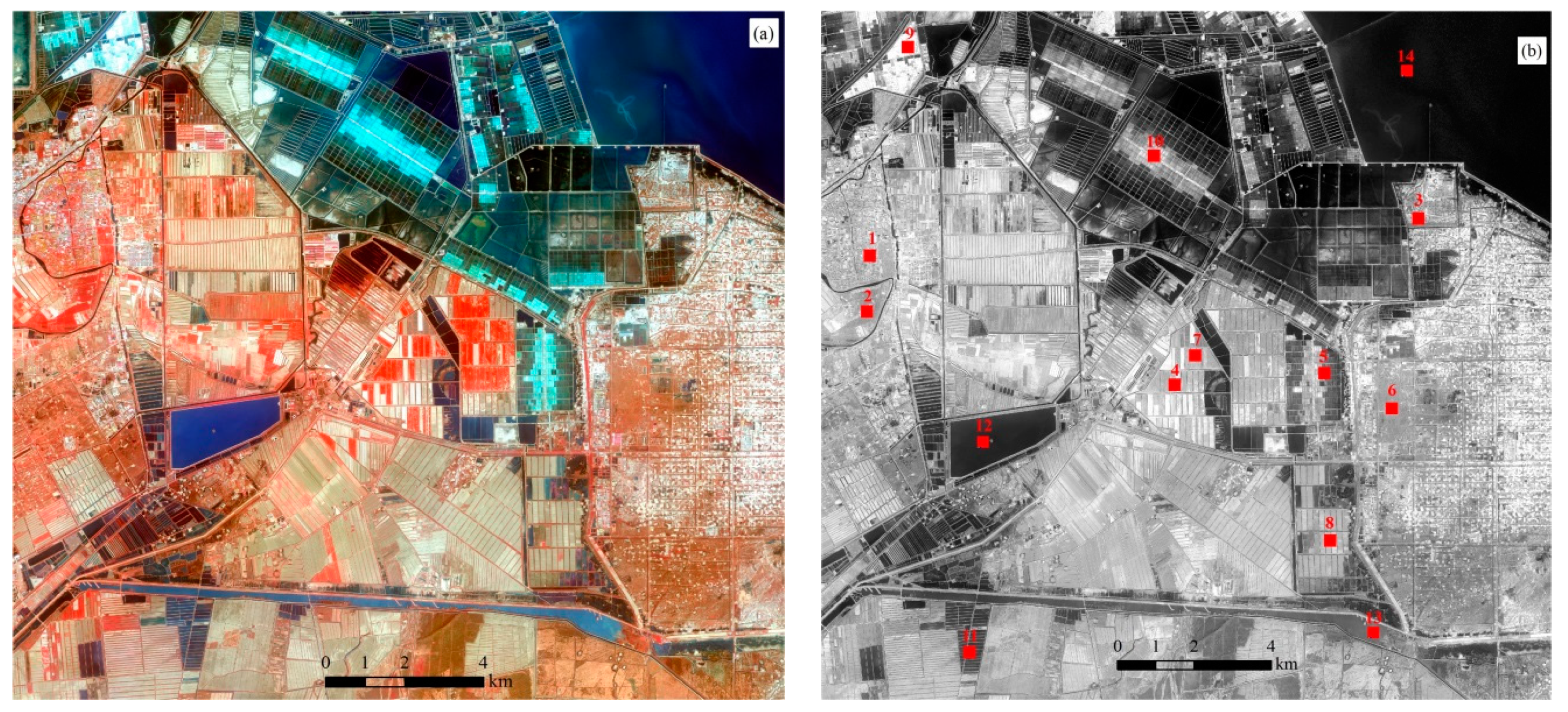

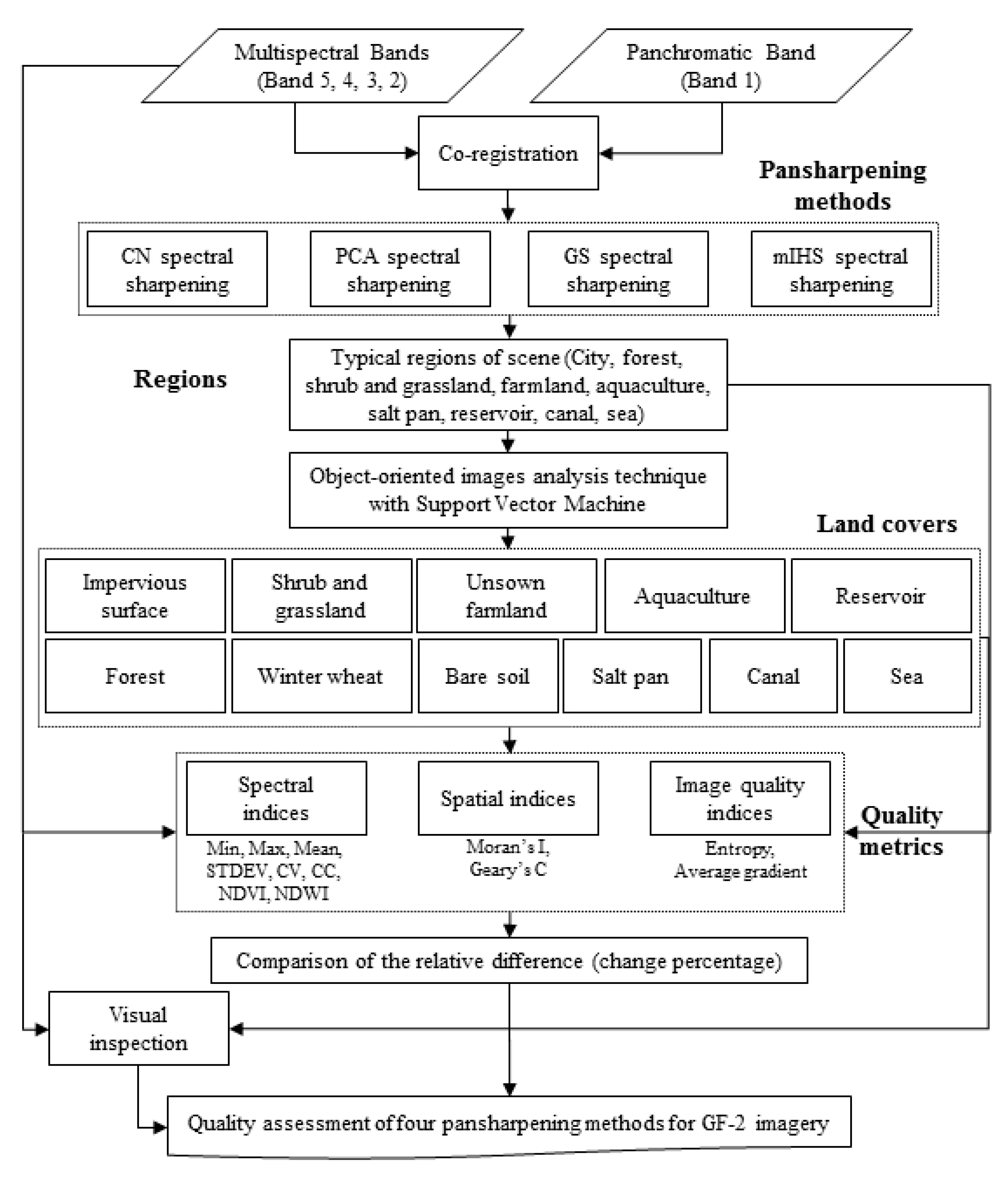
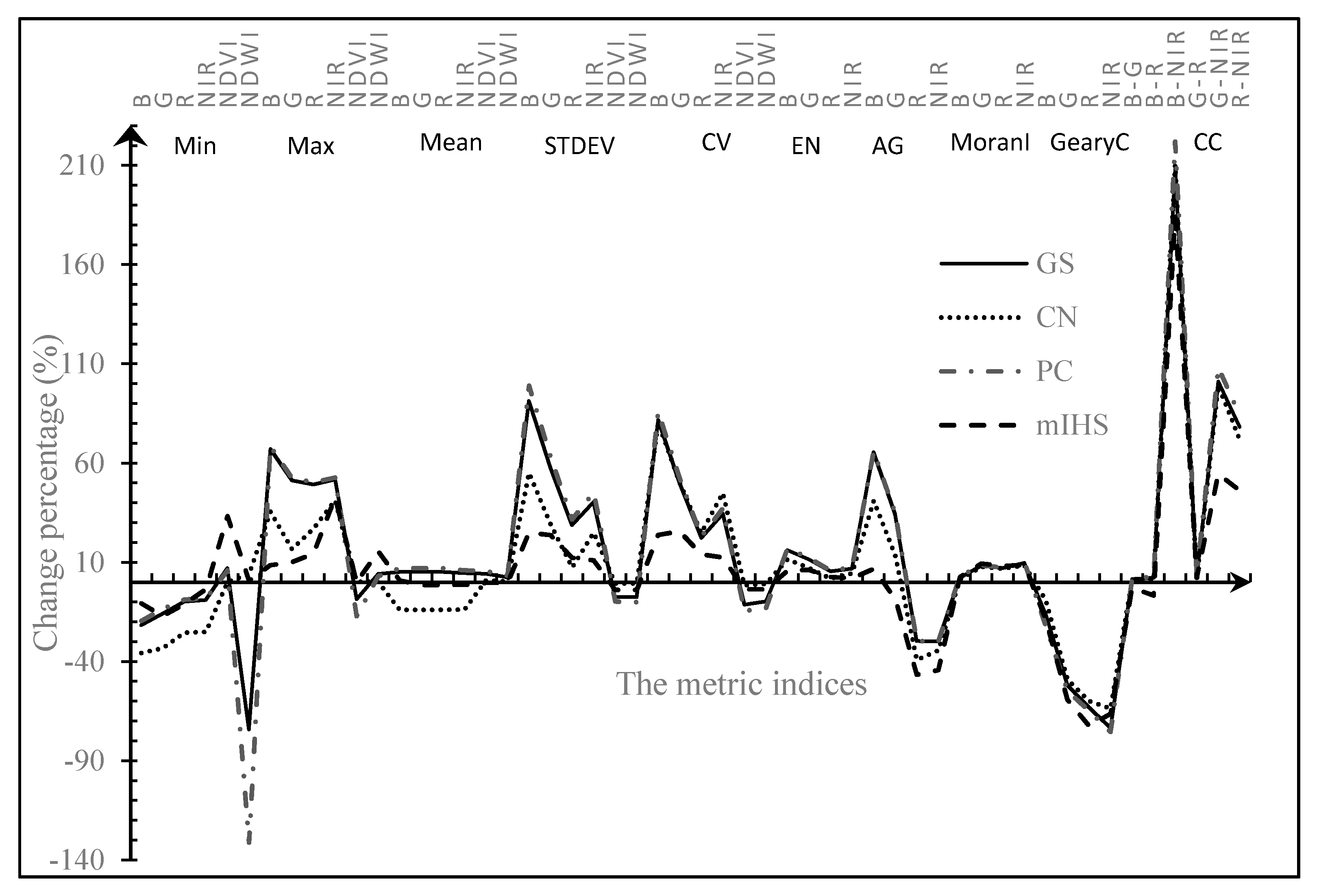


| Band Name | Spectral Ranges (nm) | Spatial Resolution (m) |
|---|---|---|
| Panchromatic | 450–900 | 1 |
| Blue | 450–520 | 4 |
| Green | 520–590 | 4 |
| Red | 630–690 | 4 |
| Near-infrared (NIR) | 770–890 | 4 |
| Region | Land Cover | Area Percentage (%) |
|---|---|---|
| Region 1 | Impervious surface | 65.2 |
| vegetation | 28.6 | |
| Region 2 | Impervious surface | 28.3 |
| forest | 71.7 | |
| Region 3 | Shrub and grassland | 47.8 |
| Bare soil | 52.2 | |
| Region 4 | Unsown farmland | 57.1 |
| Winter wheat | 30.5 | |
| Region 5 | Salt water | 57.1 |
| Salt-affected soil | 35.6 | |
| Region 6 | Shrub and grassland | 7.1 |
| Bare soil | 92.9 | |
| Region 7 | Unsown farmland | 80.7 |
| Canal water | 17.6 | |
| Region 8 | Unsown farmland | 23.5 |
| Winter wheat | 71.3 | |
| Canal water | 5.2 | |
| Region 9 | Salt water | 85.3 |
| Salt-affected soil | 24.7 | |
| Region 10 | Salt water | 62.9 |
| Salt-affected soil | 12.3 | |
| Region 11 | Aquaculture water | 79.3 |
| Ridge | 18.5 | |
| Region 12 | Reservoir water | 100.0 |
| Region 13 | Canal water | 100.0 |
| Region 14 | Sea water | 100.0 |
© 2020 by the authors. Licensee MDPI, Basel, Switzerland. This article is an open access article distributed under the terms and conditions of the Creative Commons Attribution (CC BY) license (http://creativecommons.org/licenses/by/4.0/).
Share and Cite
Liu, Q.; Huang, C.; Li, H. Quality Assessment by Region and Land Cover of Sharpening Approaches Applied to GF-2 Imagery. Appl. Sci. 2020, 10, 3673. https://doi.org/10.3390/app10113673
Liu Q, Huang C, Li H. Quality Assessment by Region and Land Cover of Sharpening Approaches Applied to GF-2 Imagery. Applied Sciences. 2020; 10(11):3673. https://doi.org/10.3390/app10113673
Chicago/Turabian StyleLiu, Qingsheng, Chong Huang, and He Li. 2020. "Quality Assessment by Region and Land Cover of Sharpening Approaches Applied to GF-2 Imagery" Applied Sciences 10, no. 11: 3673. https://doi.org/10.3390/app10113673




